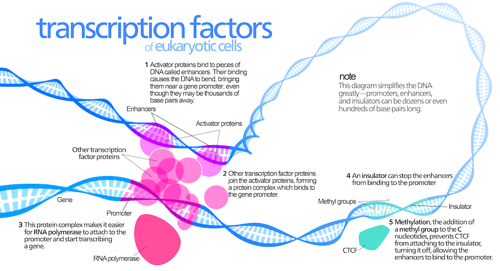
Why does the hair color of children often change color as they grow older?
October 26, 2004

- Related Topics:
- Pigmentation traits,
- Hair color
A curious adult from Kansas asks:
"Why does the hair color of children often change color as they grow older? My brother, sister and I all had light blond hair as young children which gradually darkened to brunette by the time we were teenagers. Both parents are brunette. My husband is Chinese (black hair), and both of our children started out with blond hair which is darkening now as they age. My father, though brunette, also had blond hair as a kid and has blue eyes."
This is a great question that gets at the root of what our DNA does. People's hair and eye color can change over time, they can become less tolerant of milk as they get older, etc. What is going on?
The quick answer is that for people to get the traits encoded in their genes, the genes need to be turned on. You can think of a gene as a recipe. A recipe in a cookbook does you no good until you open the book, get the ingredients and follow the instructions.
The same is true with our genes. In our analogy, the gene is the recipe and the cookbook is the chromosome (a large collection of recipes). The gene needs to be "read" by the cell in order for it to do what it should. An unread brown or black hair recipe will give you blonde hair.

Scientists don't really understand why specifically the eye and hair color genes sometimes turn on later in life. But they do have a pretty good understanding of what is going on with a much simpler case, lactose intolerance. Let's use lactose intolerance to show how eye and hair color might darken (or lighten) over time.
All mammals start out life able to digest milk. Later in life, almost all mammals lose this ability.
Mammals are able to drink milk as youngsters because they make an enzyme called lactase. Lactase breaks lactose down into more digestible sugars.
So why do mammals lose the ability to digest milk as they grow older? Because they lose the ability to make lactase -- their lactase gene is turned off.
Almost all genes are simply recipes for specific proteins. In our case, the enzyme lactase is the result of the recipe found in the lactase gene. This is a little like how chocolate chip cookies are the result of a chocolate chip cookie recipe.
So how are genes turned on and off? Genes get turned on and off with a certain kind of protein called a transcription factor (TF). At their simplest, TFs can either turn genes on or off.
TFs are called activators when they turn genes on. Activators work like a bookmark that leads us to the recipe we want. Activators turn genes on by leading the cellular gene-reading machinery to the recipe.
TFs are called repressors when they work to shut off a gene. Repressors are something like a paperclip that sticks the pages of the recipe together so that we skip right over them in our cookbook. Repressors turn genes off by making the recipe invisible to the cellular gene-reading machinery.
Most mammals stop making lactase later in life because a repressor lands near the lactase gene. The repressor makes the gene unable to be read by the cell so you get no lactase. Where did the repressor come from? For reasons we don't understand, the repressor gene is turned on by an activator!
(Many adults can drink milk because they have a mutation in their DNA such that the repressor no longer works. The result? Lactase is still made into adulthood. Click here for more details.)

As you can see, turning genes on and off is incredibly complicated. Hair and eye color can darken over time because the respective genes are turned on. This can happen either by an activator being turned on or a repressor being turned off.
Probably more than you wanted to know but there you are. What I've described is simplified a bit in that there is more than on and off. Genes can also be turned to different levels as well and we didn't even get into how the lactase repressor "knows" to go to the lactase gene and not some other gene. We need to save something for future questions...

Author: Dr. D. Barry Starr
Barry served as The Tech Geneticist from 2002-2018. He founded Ask-a-Geneticist, answered thousands of questions submitted by people from all around the world, and oversaw and edited all articles published during his tenure. AAG is part of the Stanford at The Tech program, which brings Stanford scientists to The Tech to answer questions for this site, as well as to run science activities with visitors at The Tech Interactive in downtown San Jose.
 Skip Navigation
Skip Navigation
